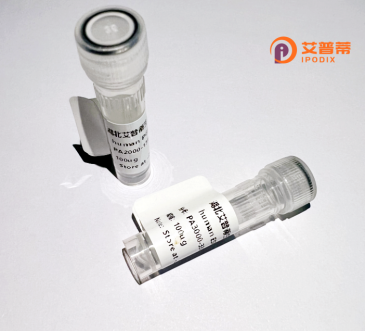
| 纯度 | >90%SDS-PAGE. |
| 种属 | Human |
| 靶点 | TRIM43 |
| Uniprot No | Q96BQ3 |
| 内毒素 | < 0.01EU/μg |
| 表达宿主 | E.coli |
| 表达区间 | 1-446 aa |
| 活性数据 | MDSDFSHAFQKELTCVICLNYLVDPVTICCGHSFCRPCLCLSWEEAQSPANCPACREPSPKMDFKTNILLKNLVTIARKASLWQFLSSEKQICGTHRQTKKMFCDMDKSLLCLLCSNSQEHGAHKHHPIEEAAEEHREKLLKQMRILWKKIQENQRNLYEEGRTAFLWRGNVVLRAQMIRNEYRKLHPVLHKEEKQHLERLNKEYQEIFQQLQRSWVKMDQKSKHLKEMYQELMEMCHKPDVELLQDLGDIVARSESVLLHMPQPVNPELTAGPITGLVYRLNRFRVEISFHFEVTNHNIRLFEDVRSWMFRRGPLNSDRSDYFAAWGARVFSFGKHYWELDVDNSCDWALGVCNNSWIRKNSTMVNSEDIFLLLCLKVDNHFNLLTTSPVFPHYIEKPLGRVGVFLDFESGSVSFLNVTKSSLIWSYPAGSLTFPVRPFFYTGHR |
| 分子量 | 52.2 kDa |
| 蛋白标签 | His tag N-Terminus |
| 缓冲液 | PBS, pH7.4, containing 0.01% SKL, 1mM DTT, 5% Trehalose and Proclin300. |
| 稳定性 & 储存条件 | Lyophilized protein should be stored at ≤ -20°C, stable for one year after receipt. Reconstituted protein solution can be stored at 2-8°C for 2-7 days. Aliquots of reconstituted samples are stable at ≤ -20°C for 3 months. |
| 复溶 | Always centrifuge tubes before opening.Do not mix by vortex or pipetting. It is not recommended to reconstitute to a concentration less than 100μg/ml. Dissolve the lyophilized protein in distilled water. Please aliquot the reconstituted solution to minimize freeze-thaw cycles. |
以下是关于TRIM43蛋白的3篇文献简介(信息综合自近年研究):
1. **《TRIM43 promotes endometrial cancer cell proliferation and metastasis》**
- **作者**:Li X, et al. (2021)
- **摘要**:研究发现TRIM43在子宫内膜癌中高表达,通过激活PI3K/AKT信号通路促进肿瘤细胞增殖、迁移和侵袭,提示其可能作为潜在治疗靶点。
2. **《TRIM43 regulates epigenetic silencing in mouse embryonic stem cells through histone ubiquitination》**
- **作者**:Zhang Y, et al. (2020)
- **摘要**:揭示TRIM43通过泛素化修饰组蛋白H2A,参与小鼠胚胎干细胞的表观遗传调控,影响基因沉默和胚胎发育过程。
3. **《TRIM43 associates with human germ cell development and chromatin remodeling》**
- **作者**:Suzuki T, et al. (2019)
- **摘要**:发现TRIM43在人类原始生殖细胞中特异性表达,可能与染色质重塑和生殖细胞早期分化相关,提示其在生殖发育中的关键作用。
**备注**:TRIM43研究集中于生殖发育和癌症领域,因其在正常组织中低表达而在多种肿瘤(如肝癌、卵巢癌)中异常高表达,其机制多涉及泛素化修饰和表观遗传调控。建议结合特定研究方向补充数据库(如PubMed)检索。
TRIM43 (Tripartite Motif-containing 43) is a member of the TRIM protein family, characterized by a conserved N-terminal tripartite motif comprising a RING finger domain, one or two B-box domains, and a coiled-coil region. These domains often confer E3 ubiquitin ligase activity, enabling TRIM proteins to regulate ubiquitination-dependent processes like protein degradation, signaling, and antiviral responses. TRIM43. primarily expressed in germ cells and during early embryonic development, is notably present in primates but absent in many other vertebrates, suggesting evolutionary specialization. It localizes to cytoplasmic structures in gametes and preimplantation embryos, hinting at roles in genomic stability, epigenetic regulation, or fertilization.
Despite limited functional studies, TRIM43 is implicated in cancer, where its aberrant overexpression in tumors (e.g., hepatocellular carcinoma, lung cancer) correlates with poor prognosis. Mechanistically, it may act as an oncoprotein by promoting cell proliferation or inhibiting apoptosis, potentially via ubiquitination-mediated modulation of signaling pathways (e.g., Wnt/β-catenin). However, its precise substrates and biological mechanisms remain unclear. TRIM43’s restricted expression pattern and conserved domains make it a candidate for exploring species-specific reproductive biology or oncogenic pathways. Recombinant TRIM43 protein, produced through engineered systems like *E. coli* or mammalian cells, enables structural and functional studies, though challenges persist in characterizing its interactions and regulatory networks. Further research is needed to clarify its physiological roles and therapeutic potential.
×